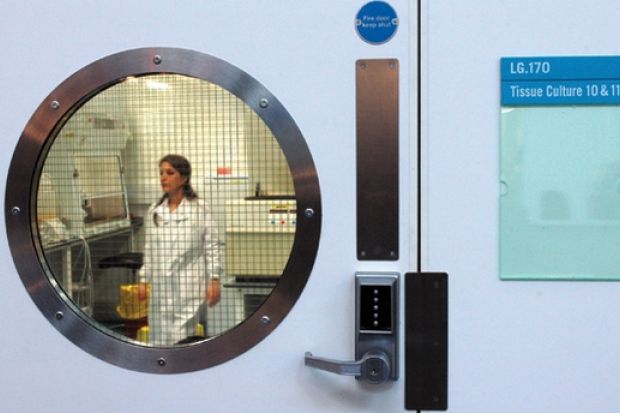Academics at Queen Mary, University of London, have warned that a proposed restructuring programme is likely to fail in its aim and could lead to a collapse in teaching quality.
The initiative is aimed at projecting Queen Mary into the top 10 per cent of UK research universities and, unusually, will explicitly measure academics against a series of metrics - including impact factors, journal rankings, research income and PhD completions - to select candidates for redundancy.
At the same time, the university proposes to recruit to other posts to boost its research credentials. The move comes amid drives by several research-intensive universities to recruit high-quality academics ahead of the 2014 research excellence framework.
Queen Mary, which recently announced that it is to join the Russell Group, has launched restructuring programmes across three major academic units during the past year. Changes in the School of Engineering and Materials Science have already been completed, but 43 jobs, including 29 academic posts, have been designated “at risk” in its School of Medicine and Dentistry.
The school needs to save £3 million a year. But it has stated its desire to maintain its high ranking in the 2008 research assessment exercise - when it was rated in England’s top five medical and dentistry schools - when the REF replaces the RAE.
Meanwhile, 11 academics at Queen Mary’s School of Biological and Chemical Sciences also received letters last week informing them that their posts were at risk amid a drive to improve the school’s research ranking.
John Allen, professor of biochemistry at Queen Mary, said improving the school’s research was a “noble objective”. But he added that the restructure proposals did not address the “central issue”: the school’s high student-staff ratio of around 20:1. “You can’t do industrial-scale teaching at high quality while maintaining the time and resources for world-class research,” he said.
Professor Allen also said the metrics being used by the school could not meaningfully be applied to individual academics.
Some staff who do not meet the research criteria will be recruited to nine new teaching-only positions, and the school plans to recruit new academics. A spokeswoman for Queen Mary said this would increase the school’s staff from 65 to 83. However, there are fears that teaching will suffer next year if staff marked for redundancy are not induced to remain until replacements have been recruited.
David Bignell, emeritus professor of zoology at Queen Mary, said the collapse of teaching programmes would fly in the face of the government’s aspiration to improve the quality of teaching. “We are essentially trying to minimise the teaching effort so we can turn in a good performance in the research excellence framework,” he said.
He argued that the best way to improve research performance would be to introduce a minimum level of internal support so that those who failed to secure external research funding were no longer “dead in the water”.
And he regarded it as unfair that those who had borne the lion’s share of teaching in the past were likely to be the ones who “get it in the neck” in the restructuring.
Concerns also exist about the redundancy programme’s supposed lack of transparency, even though the metrics used relate to publicly available information. Professor Bignell said there were widespread suspicions within the school that they had not been applied equitably.
Similar concerns were also reported to The Lancet regarding the redundancy programme in the School of Medicine and Dentistry.
‘Due process’
However, a spokeswoman for Queen Mary insisted that the reviews had followed “due process” and had been “fair and transparent”. She said changes to redundancy criteria had been made as a result of feedback from staff, and that the college had not received any complaints about bullying. “We recognise that this is a difficult and challenging time for colleagues,” she said.
“Research and teaching remain at the heart of the college ethos and the proposed changes are designed to allow Queen Mary to continue to excel in these areas. Our commitment to the local community and widening participation are core values for the college and this remains unchanged. The changes are designed to enhance our student experience and improve student satisfaction.”
Fanis Missirlis, a lecturer in cell biology at Queen Mary, insisted that if the school’s relatively low income and high teaching loads were taken into account, its research would be judged as “above excellent”. Its collegiate spirit had encouraged academics to feel that “if we all stand together” the plans could be defeated, he added.
A petition started by the University and College Union urging the college to abandon its plans for the School of Biological and Chemical Sciences has attracted more than 2,000 signatures.
A UCU spokesman said the restructuring would “wreak havoc on a fantastic teaching department which teaches more students from poorer and non-traditional backgrounds than any other at Queen Mary. The plans will cause teaching programmes to collapse, are already ruining the college’s international reputation and will do nothing to improve research outcomes.”
Register to continue
Why register?
- Registration is free and only takes a moment
- Once registered, you can read 3 articles a month
- Sign up for our newsletter
Subscribe
Or subscribe for unlimited access to:
- Unlimited access to news, views, insights & reviews
- Digital editions
- Digital access to THE’s university and college rankings analysis
Already registered or a current subscriber? Login
